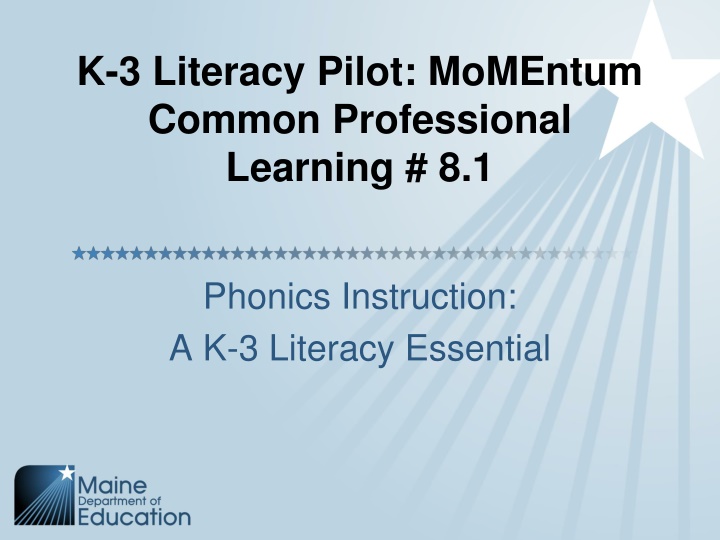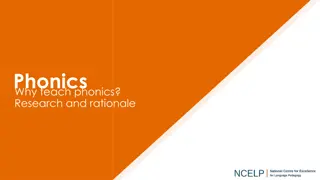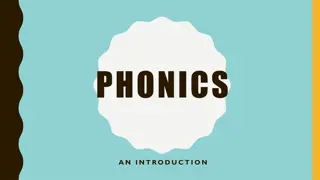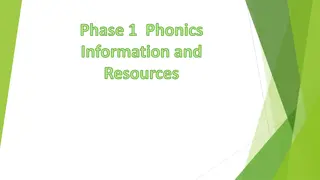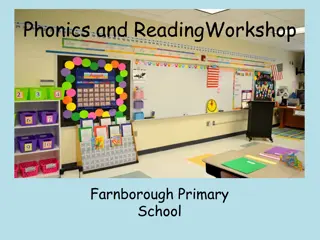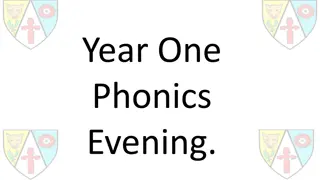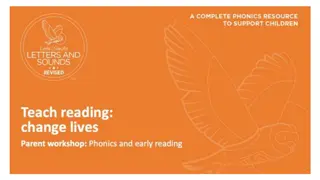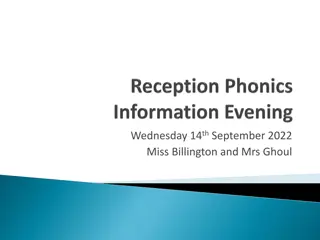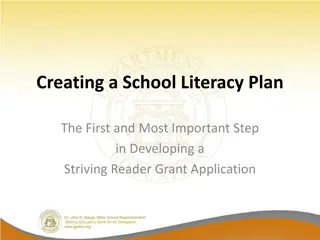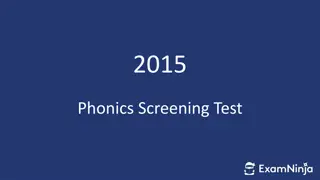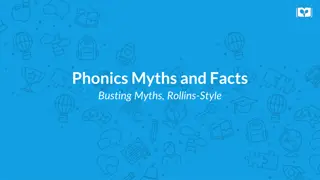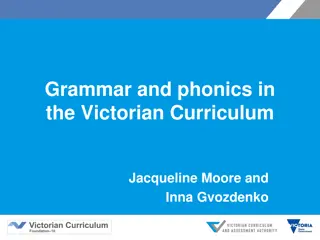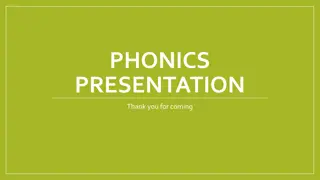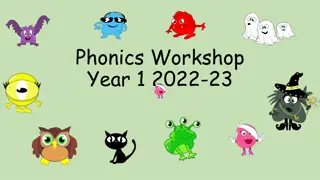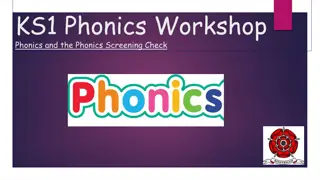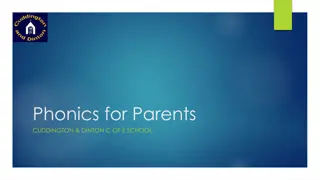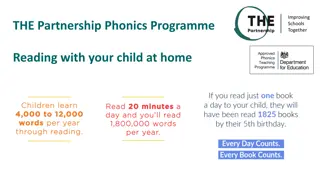Enhancing Phonics Instruction for K-3 Literacy Educators
Explore common phonics terminology, strategies to deepen decoding skills, blending techniques, word building activities, and instructional dictation to support students in phonics instruction. Discover the language of phonics, progression phases, and effective instructional strategies in this comprehensive guide. Gain insights into the importance of alphabet recognition and phonemic awareness for early reading success, along with practical tips backed by research for teaching and practicing blending in various contexts.
Download Presentation

Please find below an Image/Link to download the presentation.
The content on the website is provided AS IS for your information and personal use only. It may not be sold, licensed, or shared on other websites without obtaining consent from the author.If you encounter any issues during the download, it is possible that the publisher has removed the file from their server.
You are allowed to download the files provided on this website for personal or commercial use, subject to the condition that they are used lawfully. All files are the property of their respective owners.
The content on the website is provided AS IS for your information and personal use only. It may not be sold, licensed, or shared on other websites without obtaining consent from the author.
E N D
Presentation Transcript
K-3 Literacy Pilot: MoMEntum Common Professional Learning # 8.1 Phonics Instruction: A K-3 Literacy Essential
Learning Intentions Educators will: recognize and apply common phonics terminology. understand how to enhance blending work to provide deeper, richer, more differentiated decoding practice. understand how to transition students growing reading skills to writing through instructional dictation. recognize word building and word sorts are par of a phonics instructional cycle. experiment with blending, dictation & word sort activities in order to apply with students.
The Language of Phonics consonant vowel blend consonant digraph vowel digraph r-controlled vowel variant vowels diphthongs syllables onset rime phonogram schwa
Progression of Phonics Pre-alphabetic phase Partial alphabetic phase Full alphabetic phase Consolidated alphabetic phase (orthographic)
Instructional Strategies for Phonics Alphabet Blending and blending lines Dictation Word Building Word Sorts Word Ladders Syllabication High frequency words Decodable text
Alphabet The two best predictors of early reading success are alphabet recognition and phonemic awareness. Marilyn Jager Adams In addition to alphabet recognition and phonemic awareness, children need to have: a sense of story. a basic sense of the concepts of print. a firm grasp of the language of instruction.
Blending Blending is the main strategy we teach students to decode, or sound out, words. Blending is the stringing together of letter sounds to read a word. Example: If a students sees the word sat, he will say the sound for each letter or spelling (/s/, /a/, /t/ and string or sing together the sounds (/sat/.
Blending Research shows: Teachers who spend larger than average amounts of time on blending- modeling blending and providing loads of practice blending words in isolation and in context (e.g., daily reading instruction and practice )- achieve greater student gains. (Haddock, 1978;Rosenshine& Stevens, 1984)
Types of Blending Final Blending blending one sound at a time as you work through the word. Successive Blending blending or melting each sound into the next. Start with final blending but move to successive blending which is more efficient.
Practice Blending Routines Final Blending: /s/ /s/ /i/ /s/ /i/ /p/ Successive Blending: /s/ /i/ /p/
Blending: Keys to Success Begin with letters that have continuous sounds (vowels, f, l, m, n, r, s, v, z). Spend time decoding words in connected text as well as in isolation. Practice blending high utility words. Let the learners do the heavy lifting and thinking.
Practice Blending Routines Blending Lines: Line 1 (vary initial sound) Line 2 (vary final sound) Line 3 (vary medial sound) Line 4 (mixed set, target skill) bus Line 5 (review for mastery) Line 6 (review for mastery) Line 7 (challenge) Line 8 (connected text) Line 9 (connected text) up cup cap cup cut cup dug led tap stuck pup bug pop fun hip fog struck but bun pup gum rock beg fluff cut hug bug jug dot tan stuff hut hum bag nut rip lid plug map fell truck The big red bug hid. The big red bug hid under the rug.
Important Aspects of Blending Routines Model only one or two words at the beginning of the word set. Have students read the words chorally the first time through. Revisit the blending lines quickly by pointing to words in random order and calling on students to read each one. Use the blending lines for multiple days as a quick review or warm up. Make copies to take home. Draw words and sentences from upcoming stories.
Dictation (Encoding) Dictation is guided spelling. Dictation is a way for teachers to model and provide supported practice for a student in how to transfer phonics skills from reading to writing. The great benefit of dictation is that it can accelerate students use of taught phonics skills in their writing.
Dictation Dictation (encoding) should be part of weekly phonics instruction, at least twice a week. Research shows: Students learn letter sound relationships and spellings as they write.
Dictation Keys to Success Dictation should begin as early as Kindergarten and can be introduced as soon as letter-sound relationships are taught. Replace counters with letters when using Sound Boxes. Observe students during writing and check writing samples for application and transfer of phonics skills. Use dictation to model how to write words and thinking aloud the process. Spelling should not be taught haphazardly. Increased opportunities for writing words.
Dictation Activities The word is /sat/. Sound /sat/. /s/ /a/ /t/ What s the beginning sound? /s/ Write /s/. What word are you writing? sat What s the next sound? /a/ Write /a/ What word are you writing? sat What do you have so far? /sa/ Next sound? /t/ Write /t/ What is the word? sat What are the sounds? /s/ /a/ /t/
Dictation Lines Line 1 (words with new skill) mop not fox Line 2 (words with review) clap stick lift Line 3 (sentence) The frog can hop. Line 4 (sentence) The frog can hop on top of the rock.
Word Awareness Word building building fluency with blending and phonemic isolation Blending make a word and change a letter sound, then read the new word Make sat. Change the /s/ to a /m/. What is the new word. Word awareness make a word, change a letter sound to make a new word Make sat. Change sat to mat.
Word Awareness Word sorts draw students attention to common patterns. Open Closed Timed Word Ladders Combine phonics with word meaning
Success Criteria I can recognize and apply common phonics terminology. understand how to enhance blending work to provide deeper, richer, more differentiated decoding practice. understand how to transition students growing reading skills to writing through instructional dictation. recognize word building and word sorts are par of a phonics instructional cycle. experiment with blending, dictation & word sort activities in order to apply with students.
Try It On Look at your phonics activities sequence, does it progress from easiest to more complex? Work with your coach or colleagues to adjust if need be. Try on blending lines with your students. Ask your coach to co-plan and teach the lesson. Or have the coach take note of the language you are using. During shared reading, try teaching some concepts of print items. Have your coach model or observe the lesson.
Try It On Try out some of the phonics activities discussed in professional learning. Have your coach collect student data to discuss after the lesson. Try out some of the phonics activities discussed in professional learning. Have your coaches show you how to enhance them with technology.
